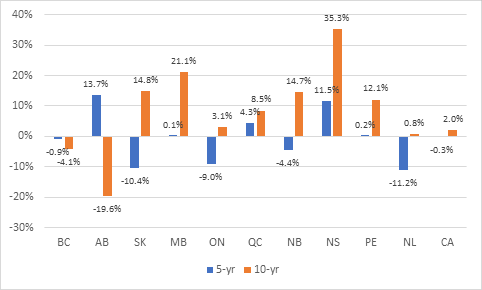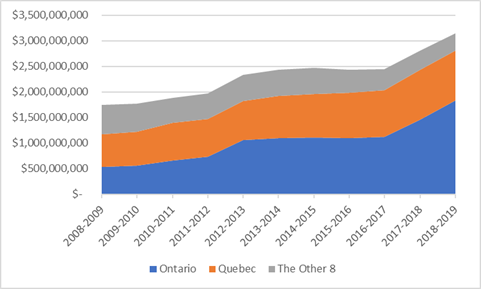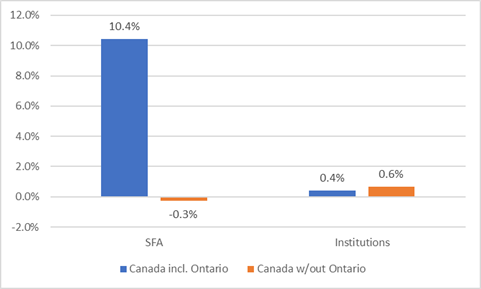The Government of Saskatchewan delivered its budget yesterday which means that all ten provinces are now in – much earlier than usual (there’s usually one irritating May holdout). And guess what? It’s another year of (on aggregate at least) barely keeping up with inflation!
Figure 1 shows changes in budgeted year-on-year transfers to institutions, in constant dollars. The national increase is 0.4%, with a big gain in Quebec offsetting a small decrease in Ontario and a larger one in Alberta (but hey! Tuition is frozen and that’s what counts, right?)
Figure 1: 1-year Change in Real Budgeted Transfers to Institutions 2018-2019, by province
Figure 2 shows changes in budgeted spending over 5- and 10-year time spans. The interesting thing to note here is how different each of the provinces look. British Columbia is the only province spending less than it was both five and ten years ago; Alberta is the only one spending more than it was five years ago but less than it was ten. Most common is a province spending less than it was five years ago, but more than it was ten years ago, reflecting basically that 2008-2013 was a heck of a lot better for PSE than the last five years have been. Only in Nova Scotia and Quebec has PSE spending risen over both time horizons. Nationally, spending is 1.9% higher than it was a decade ago (when there were around 170,000 fewer domestic students in the system) but -0.3% lower than it was five years ago.
Figure 2: 5- and 10-year Changes in Real Budgeted Transfers to Institutions 2018-2019, by province
Only two provinces saw major increases in student aid: Ontario with a jump of 25% (which I described on Monday) and Prince Edward Island with an increase of 40%. The PEI story combines a couple of initiatives. The first was a bump in the set of non-need-based bursaries – PEI is the only province that has such a thing – given to Island students who attend UPEI or Holland College (because in the Maritimes, students must be financially disadvantaged if they have the temerity to leave the province). But the second was a change in the income-based portion of the student aid system to give the province a targeted free tuition system like New Brunswick’s and Ontario’s, where tuition is free to families with under $75,000 in income (assuming a family of four). Weirdly, however, the government is actually shying away from labelling it a “free tuition for low/middle-income students” program and is just saying “lots of people will no longer be paying tuition” without actually saying who.
(Saskatchewan by the way, was the one province with a major cut: they lopped over a quarter off their student aid budget, mainly by doing away with their education savings grant program. If you’re going to cut student aid, that’s the place to do it)
Anyways, here’s the evolution of provincial spending on student financial aid over the past ten years. The story here is partially one of Ontario’s massive expansion, but also one of big drops in some other provinces, notably Saskatchewan and British Columbia.
Figure 3: Provincial Student Aid Expenditures, by Province (sort of), 2008-09 to 2018-2019, in constant 2018 Dollars
And finally, here’s a summary chart, the net change in total spending on SFA and institutional grants, both with and without Ontario. Nationally, there appears to be a massive change in year-over-year student aid spending, but in fact if you exclude Ontario, there has actually been a drop in student financial aid expenditures. Conversely, the growth in provincial spending on institutions increases from 0.4% to 0.6% if Ontario is excluded from the calculations.
Figure 4: Real Change in Aggregate Budgeted Expenditures, 2018-19 vs. 2017-18
Prediction: these anemic increases, plus ongoing limitations on tuition increases, mean institutions will still be looking hungrily for international students this year to balance the books. Bank on it.





 Tweet this post
Tweet this post
